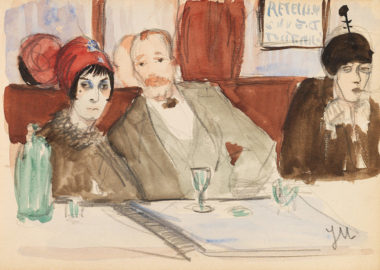Mammen, Jeanne
Sold Artworks
Biography
Jeanne Mammen
1890 – Berlin – 1976
The daughter of a wealthy businessman, Jeanne Mammen was born in Berlin. In 1895, the Mammen family moved to Paris. She began her artistic training at the age of sixteen at the Académie Julian, a private art school, as a pupil of the school’s ‘atelier des Dames’. In 1908 she enrolled at the Académie Royale des Beaux-Arts in Brussels. Under the influence of Belgian Symbolism she began to engage intensively with themes such as love and death, drawing inspiration from the morbid visions of Félicien Rops and the dark, otherworldly imagery of Fernand Khnopff. She went on to produce a striking series of gouaches that are rich in colour and replete with phantasy. The gouaches mark a first high point in her oeuvre. From 1911-12 she attended classes at the Accademia di Belle Arti in Rome before returning to Paris in 1912.
On her return, Mammen focused her interest on daily life in the capital, chronicling scenes on the boulevards and in the city’s cafes, bars and dance halls. Her repertoire of subjects ranged from images of destitute casual workers and seedy streetwalkers to elegant flaneurs, narcissistic dandies and dancing couples. Never without a sketchbook, she captured her impressions incessantly in pencil and watercolour. Possessing acute powers of observation, she produced spontaneous, rapidly sketched drawings that have the immediacy of snapshots, many of them with caricatural overtones. She was an acute observer of gestures and facial expressions, with a particular eye for fashionably dressed figures. Within just a few years she was to build up a rich reservoir of motifs which served as the basis for the works she produced in the 1920s.
As German citizens, Jeanne and her family were forced to flee Paris when World War I broke out. In 1915, via a somewhat circuitous route, she arrived in Berlin. But the family fortune was lost and she was obliged to support herself earning a living as an artist.
In the mid 1920s, Mammen began to earn broad recognition for her illustrations for the satirical journals Jugend, Simplicissimus, ULK and UHU. As in Paris, she continued to focus chiefly on subjects drawn from her observation of modern city life. She recorded a powerful pictorial cross-section of life in the upper and lower echelons of society. Her portrayal of social conditions in the Weimar Republic was neither romanticized, nor bitingly critical like that of Otto Dix, George Grosz and Rudolf Schlichter. On the contrary, setting out from a distanced, unsentimental form of realism, she developed an objective narrative style which also displayed caricatural elements. In this, her work is comparable to that of Karl Arnold and Dodo, fellow contributors to Simplicissimus and ULK. But Mammen’s particular interest in lesbian life observed in the bars, clubs and cafes of the gay-lesbian milieu is what sets her apart from her colleagues.
When the Nazis seized power in 1933 Mammen’s activity as a magazine contributor came to an abrupt end. Her work was defamed as ‘degenerate’ and banned from publication and exhibition. During the years of National Socialism she was obliged to eke out a living as a casual labourer. But she nevertheless continued to work secretly, albeit in a style redolent of cubo-expressionism. After the war she followed the path to a reduced, almost poetic form of abstraction. Although her creative energy remained unbroken up to the end of her life, she was unable to replicate the earlier successes of the 1920s when she ranked as one of the leading women artists of her time.
PDF Download